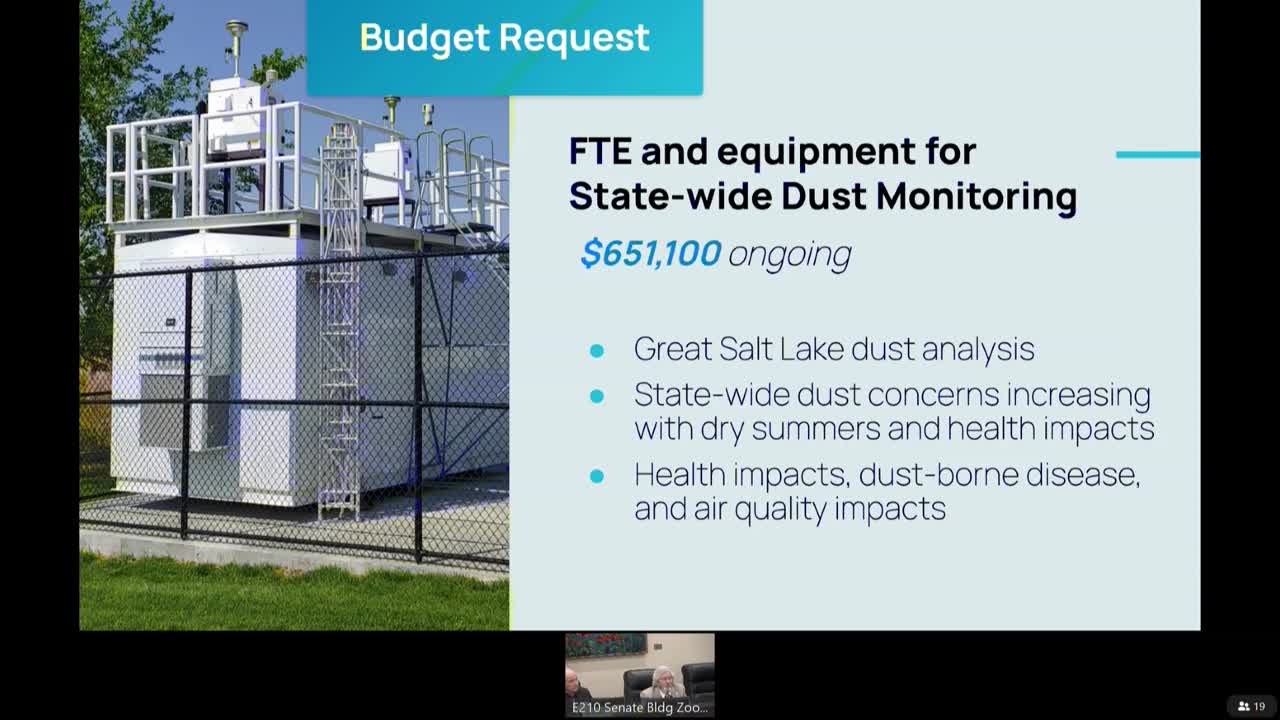Bryce Byrd advocates for dust monitoring and prevention efforts at Great Salt Lake
January 31, 2025 | 2025 Utah Legislature, Utah Legislature, Utah Legislative Branch, Utah
This article was created by AI summarizing key points discussed. AI makes mistakes, so for full details and context, please refer to the video of the full meeting. Please report any errors so we can fix them. Report an error »

In a recent meeting of the Natural Resources, Agriculture, and Environmental Quality Appropriations Subcommittee, the focus turned to the pressing issue of dust pollution stemming from the Great Salt Lake. Under the bright lights of the legislative chamber, Bryce Byrd, the director of the Division of Air Quality, presented a budget request aimed at addressing this environmental challenge.
Byrd emphasized the importance of understanding and monitoring dust issues across Utah, particularly as they relate to health concerns like desert fever. He noted that the state has seen a rise in such health issues, which can be exacerbated by dust storms originating from the drying lake beds. "We don’t know what we don’t measure," Byrd stated, highlighting the need for additional resources to conduct research and collect dust samples for analysis.
The discussion also touched on the lack of a formal Dust Suppression Act Plan in Utah. Currently, efforts are primarily focused on surveillance and research rather than active suppression measures. Byrd acknowledged that while there are no current suppression activities in place, lessons learned from California's Owens Lake could guide Utah in developing proactive strategies. He pointed out that California has spent billions on dust mitigation, a costly endeavor that Utah aims to avoid by acting swiftly.
The committee members expressed support for Byrd's budget request, recognizing the urgency of the situation. One representative underscored the importance of gathering accurate data to inform future actions, suggesting that early intervention could prevent the need for extensive and expensive mitigation efforts down the line.
As the meeting concluded, the sense of urgency surrounding the Great Salt Lake's dust issues lingered in the air. With the potential for significant health impacts and environmental degradation, the discussions highlighted a critical moment for Utah's lawmakers to take decisive action in safeguarding both public health and the state's natural resources.
Byrd emphasized the importance of understanding and monitoring dust issues across Utah, particularly as they relate to health concerns like desert fever. He noted that the state has seen a rise in such health issues, which can be exacerbated by dust storms originating from the drying lake beds. "We don’t know what we don’t measure," Byrd stated, highlighting the need for additional resources to conduct research and collect dust samples for analysis.
The discussion also touched on the lack of a formal Dust Suppression Act Plan in Utah. Currently, efforts are primarily focused on surveillance and research rather than active suppression measures. Byrd acknowledged that while there are no current suppression activities in place, lessons learned from California's Owens Lake could guide Utah in developing proactive strategies. He pointed out that California has spent billions on dust mitigation, a costly endeavor that Utah aims to avoid by acting swiftly.
The committee members expressed support for Byrd's budget request, recognizing the urgency of the situation. One representative underscored the importance of gathering accurate data to inform future actions, suggesting that early intervention could prevent the need for extensive and expensive mitigation efforts down the line.
As the meeting concluded, the sense of urgency surrounding the Great Salt Lake's dust issues lingered in the air. With the potential for significant health impacts and environmental degradation, the discussions highlighted a critical moment for Utah's lawmakers to take decisive action in safeguarding both public health and the state's natural resources.
View full meeting
This article is based on a recent meeting—watch the full video and explore the complete transcript for deeper insights into the discussion.
View full meeting

